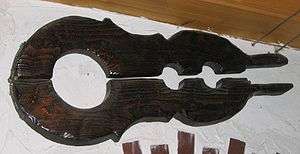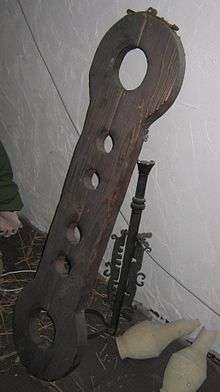Shrew's fiddle

A shrew's fiddle or neck violin is a variation of the yoke, pillory or rigid irons whereby the wrists are locked in front of the bound person by a hinged board or steel bar. It was originally used in the Middle ages as a way of punishing women who were caught bickering or fighting.[1]
History

The shrew's fiddle was used in medieval Germany and Austria, where it was known as a Halsgeige, meaning "neck viola"[1] or "neck violin".[2] It was originally made out of two pieces of wood fitted with a hinge and a lock at the front. The shrew's fiddle consisted of three holes. One was a large hole for the neck and the other two were smaller holes which fastened the wrists in front of the face.[1]
A bell was sometimes attached to this portable pillory, to alert townspeople that the victim was approaching so that she might be mocked and otherwise humiliated. Another version was a "double fiddle" by which two people could be attached together face-to-face, forcing them to talk to each other. They were not released until the argument had been resolved.[3]
See also
References
- 1 2 3 "Museum of Medieval legal history - Halsgeige (neck-viola) and Shame-mask - Medieval torture". Retrieved 2008-05-04.
- ↑ Rublack, Ulinka (1999). The Crimes of Women in Early Modern Germany. Oxford University Press. p. 75. ISBN 0-19-820637-2.
- ↑ "Rothenburg". Retrieved 2008-05-04.
